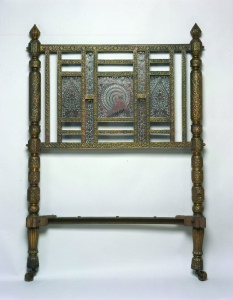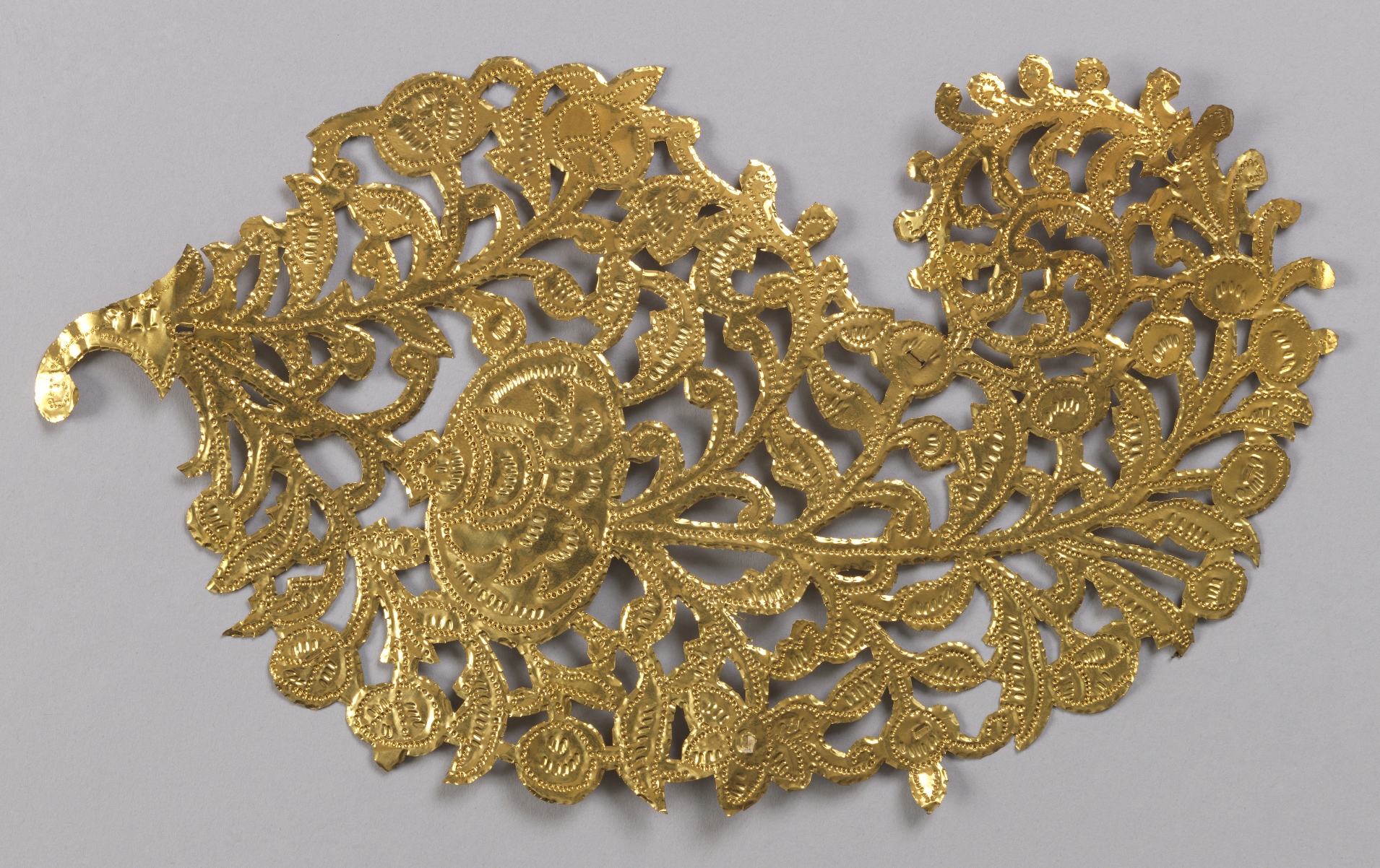This brass foil decoration in what we know as a paisley form represents an example of the designs created by Lockwood de Forest, the foremost exponent of Indian design in America during the last quarter of the nineteenth and early twentieth centuries. De Forest went to India in 1881 on his honeymoon to see first-hand what objects he could collect and what designs might be relevant to creating rich and exotic interiors in collaboration with his then-partner and friend Louis Comfort Tiffany, as well as Candace Wheeler. He soon set up a firm and studio, with the help of a Jain merchant-banker, Muggunbhai Hutheesing, in Ahmedabad, a major textile city in the state of Gujarat. Hutheesing led him to the mistri, or master craftsmen his family had employed while his father was a head of a trade guild and whom de Forest hired to create the Ahmedabad Woodworking Company. While the firm produced both panelling and furniture using Indian carved motifs selected, combined and organized by de Forest to appeal to western taste, de Forest saw the universality of the motifs, and adopted some for stencils to create decorative walls, and metalwork to cover furniture, and decorate interiors, such as this brass foil. The foils could be a variety of shapes and some owe their sources to architectural elements rather than textiles. The word paisley comes from the town in Scotland where many wool blankets and shawls using the motif became fashionable and heavily exported earlier in the nineteenth century.
Both wood and metalwork shared a common system for de Forest to order them when back in the United States. Sample pieces of both wood and metal generally have numbers on them, from which de Forest could order specific patterns by mail, using the numbering system, or pattern shape. In this case, the number 175 seen near the edge, would refer to this particular paisley motif and size. De Forest saw that design sources from one media could be translated to another, as is seen from using the paisley motif which is almost certainly based on Indian textile designs, but other examples might be based on jalis (open decorative screens) or applied to stencils, such as those on the walls of Cooper Hewitt’s Teak room, formerly the Carnegie family library, which were also de Forest creations.
Sets of both the numbered wood panel samples and numbered brass foils exist that descended in the de Forest family, as this example did. De Forest seems to have thought such foils decorative brass accessories for interiors but does not seem to have used them as much as he did the carved wood paneling. An exception was his work at the Bryn Mawr College Deanery, where the blue-painted ceiling and frieze along with exposed dark ceiling beams had foils applied over them, and reflect light in a playful way, adding to the contrast of the dark wood with light and decorative relief. Paisley motifs also appear in the repertory of brass foils at Bryn Mawr.
De Forest also created metal-covered wood furniture, such as the beds with headboard and footboard of chased brass and pierced copper over a teak core that major patron Mary Garrett appears to have commissioned for an interior in Baltimore about 1885-7 and then brought with her to Bryn Mawr college when she moved there in 1904.

Bed Headboard, Designed by Lockwood de Forest for Mary Garrett, ca. 1885; Chased brass over teak and pierced brass and copper.
Both this foil, a very recent gift of Sullivan Goss – An American Gallery to the museum, which descended from Lockwood de Forest’s own collection through his family until fairly recently, along with the bed headboard loaned by Bryn Mawr College, will appear in the exhibition Passion for the Exotic: Lockwood de Forest and Frederic Church beginning December 12, 2014.
Sarah D. Coffin is Curator and Head of the Product Design and Decorative Arts Department of Cooper Hewitt Smithsonian Design Museum. She also co-curated, with Gail S. Davidson, the exhibition Passion for the Exotic: Lockwood de Forest and Frederic Church which will be featured in the re-opening exhibitions.
